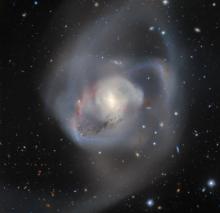Listen to today's episode of StarDate on the web the same day it airs in high-quality streaming audio without any extra ads or announcements. Choose a $8 one-month pass, or listen every day for a year for just $30.
You are here
Green Peas
Thousands of green peas float through the universe. They weren’t strewn about by the Jolly Green Giant. Instead, they’re small, busy galaxies — little nibbles that are giving birth to new stars.
The galaxies were discovered by volunteers who were looking through pictures of many galaxies. The pictures were snapped as part of an extensive survey of the sky. The volunteers began to see objects that were small, round, and green. In other words, they looked just like green peas.
Astronomers looked at some of these galaxies in detail. They found that the green peas are small and not very massive. They’re generally found in regions with few other galaxies.
But they’re giving birth to vast numbers of stars — the equivalent of about 10 Suns every year. That’s a few times the rate in our home galaxy, the Milky Way. But when you consider that the green peas are only a tiny fraction of the mass of the Milky Way, the numbers are quite impressive.
The high rate of starbirth may be the result of encounters between galaxies. As galaxies swing past each other — or even merge — big clouds of gas and dust smash together, triggering the birth of new stars.
Most of the green peas are fairly close. But they may be like some of the earliest galaxies in the universe, which later merged to form bigger galaxies. So studying these little galaxies may help us learn about conditions when the universe was young — and stuffed with green peas.
Script by Damond Benningfield






